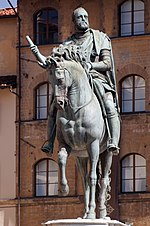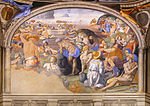Republic of Florence

The Republic of Florence, officially the Florentine Republic (Italian: Repubblica Fiorentina, pronounced [reˈpubblika fjorenˈtiːna], or Repubblica di Firenze), was a medieval and early modern state that was centered on the Italian city of Florence in Tuscany. The republic originated in 1115, when the Florentine people rebelled against the Margraviate of Tuscany upon the death of Matilda of Tuscany, who controlled vast territories that included Florence. The Florentines formed a commune in her successors' place. The republic was ruled by a council known as the Signoria of Florence. The signoria was chosen by the gonfaloniere (titular ruler of the city), who was elected every two months by Florentine guild members. During the Republic's history, Florence was an important cultural, economic, political and artistic force in Europe. Its coin, the florin, became a world monetary standard. During the Republican period, Florence was also the birthplace of the Renaissance, which is considered a fervent period of European cultural, artistic, political and economic "rebirth".The republic had a checkered history of coups and countercoups against various factions. The Medici faction gained governance of the city in 1434 under Cosimo de' Medici. The Medici kept control of Florence until 1494. Giovanni de' Medici (later Pope Leo X) reconquered the republic in 1512. Florence repudiated Medici authority for a second time in 1527, during the War of the League of Cognac. The Medici reassumed their rule in 1531 after an 11-month siege of the city, aided by Emperor Charles V. Pope Clement VII, himself a Medici, appointed his relative Alessandro de' Medici as the first "Duke of the Florentine Republic", thereby transforming the Republic into a hereditary monarchy.The second Duke, Cosimo I, established a strong Florentine navy and expanded his territory, conquering Siena. In 1569, the pope declared Cosimo the first grand duke of Tuscany. The Medici ruled the Grand Duchy of Tuscany until 1737.
Excerpt from the Wikipedia article Republic of Florence (License: CC BY-SA 3.0, Authors, Images).Republic of Florence
Via della Ninna, Florence Quartiere 1
Geographical coordinates (GPS) Address Nearby Places Show on map
Geographical coordinates (GPS)
| Latitude | Longitude |
|---|---|
| N 43.769444444444 ° | E 11.256111111111 ° |
Address
Palazzo Vecchio
Via della Ninna
50122 Florence, Quartiere 1
Tuscany, Italy
Open on Google Maps











